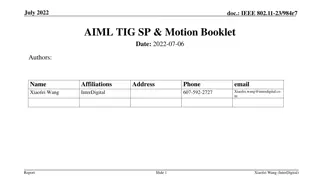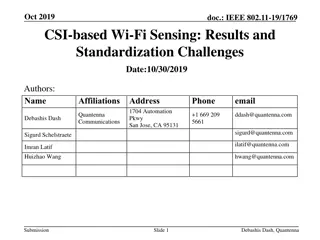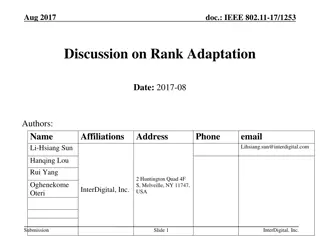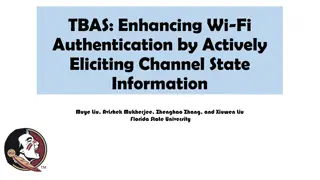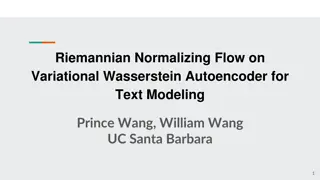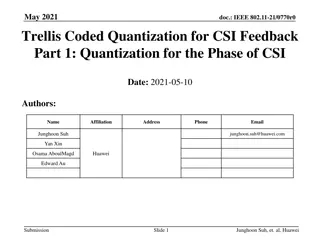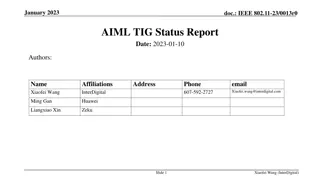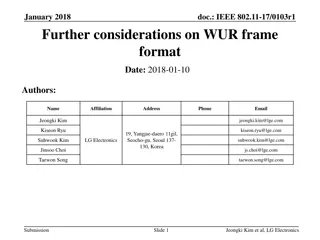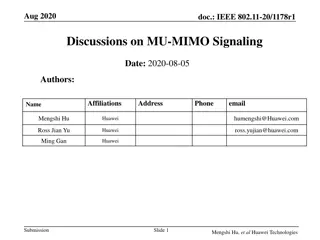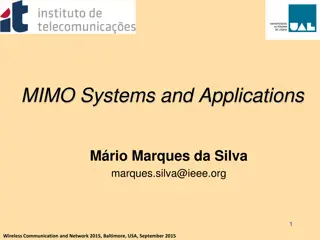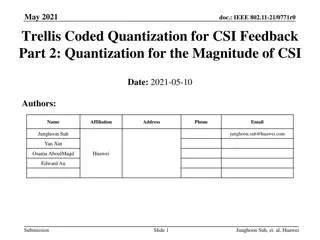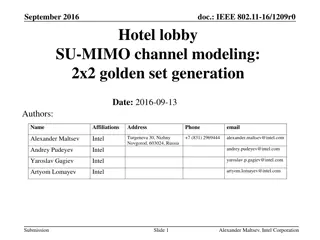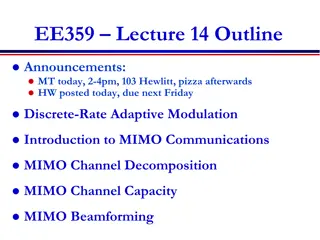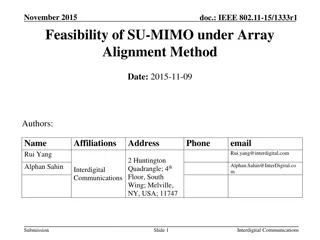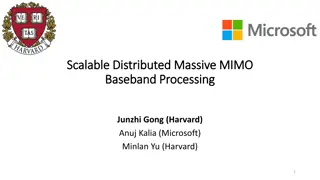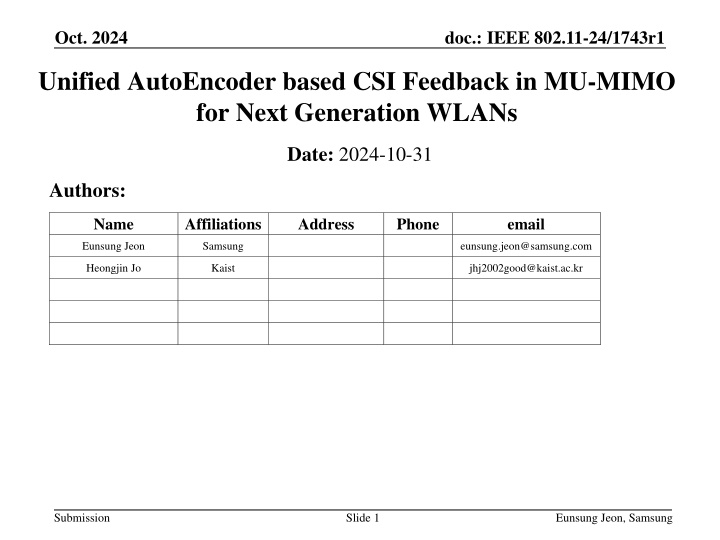
Unified AutoEncoder based CSI Feedback in MU-MIMO for Next Generation WLANs
Explore how Deep Neural Network AutoEncoder (DNN-AE) can minimize CSI feedback overhead while enhancing performance in MU-MIMO for future WLAN networks. The proposed scheme aims to reduce training efforts and hardware complexity by applying a unified DNN-AE across various CSI types, bandwidths, antenna configurations, and MIMO modes. Discover the key advantages and contributions of this innovative approach in leveraging unsupervised learning techniques for efficient CSI feedback compression.
Download Presentation

Please find below an Image/Link to download the presentation.
The content on the website is provided AS IS for your information and personal use only. It may not be sold, licensed, or shared on other websites without obtaining consent from the author. If you encounter any issues during the download, it is possible that the publisher has removed the file from their server.
You are allowed to download the files provided on this website for personal or commercial use, subject to the condition that they are used lawfully. All files are the property of their respective owners.
The content on the website is provided AS IS for your information and personal use only. It may not be sold, licensed, or shared on other websites without obtaining consent from the author.
E N D
Presentation Transcript
Oct. 2024 doc.: IEEE 802.11-24/1743r1 Unified AutoEncoder based CSI Feedback in MU-MIMO for Next Generation WLANs Date: 2024-10-31 Authors: Name Affiliations Address Phone email Eunsung Jeon Samsung eunsung.jeon@samsung.com Heongjin Jo Kaist jhj2002good@kaist.ac.kr Submission Slide 1 Eunsung Jeon, Samsung
Oct. 2024 doc.: IEEE 802.11-24/1743r1 Introduction During the AIML TIG, we have explored various AIML use-cases and their feasibility for WLAN networks, which include [1] CSI feedback compression Distributed channel access Roaming enhancement Multi-AP coordination In the topic of CSI feedback compression, studies have shown that AIML technique can significantly reduce the CSI feedback overhead and improve system throughput. Motivated by the fact that CSI may fall into different clusters due to similarity of nearby non-AP STA channels, [2] applies the unsupervised learning, i.e., K- means algorithm, to classify the CSI angle vectors. Using the fact that any unitary matrix can be expressed by multiplication of two unitary matrices, i.e., V = V1V2, a dual CSI feedback scheme was proposed in [3], which decomposes a large sized CSI into a sub-band CSI (V1) using the codebook from K-means algorithm and a sub-carrier CSI (V2) using the Givens rotation. Submission Slide 2 Eunsung Jeon, Samsung
Oct. 2024 doc.: IEEE 802.11-24/1743r1 Introduction Another unsupervised learning technique, Deep Neural Network AutoEncoder (DNN-AE) can also be applied to CSI feedback compression [4],[5],[6]. Experimental results show that in SU-MIMO the algorithm reduces the feedback overhead by more than 50% and significantly increases the network throughput. However, studies covered in AIML TIG have limitations in that the performance gains were shown only in SU-MIMO. Compared with SU-MIMO, MU-MIMO performance is very sensitive to CSI accuracy to support the inter- user interference cancellation. And, thus it requires larger CSI feedback overhead (with inclusion of the MU- exclusive delta-SNR information) e.g.) Quantization bits for {?,?} is {9, 7} for MU and is {6, 4} for SU, respectively. In addition, more frequent sounding transmission is required for MU-MIMO. Therefore, the issue of CSI feedback compression is more critical in MU-MIMO rather than SU-MIMO. Slide 3 Submission Eunsung Jeon, Samsung
Oct. 2024 doc.: IEEE 802.11-24/1743r1 Main Contributions In this contribution, we investigate the DNN-AE based CSI feedback scheme, focusing on MU-MIMO with following objective Minimizing CSI feedback overhead while maintaining packet error rate (PER) performance. The key advantages the proposed scheme are A single unified DNN-AE can be applied universally to different combinations of CSI types, bandwidth, transmit and receive antenna numbers, MIMO-modes. CSI type: ?, ?, and SNR BW: 20/40/80/160/320 MHz Transmit and receive antenna number: 4x2, 8x2, 16x2, etc. MIMO mode: SU-MIMO / MU- MIMO This structure not only alleviate burden on training efforts but also reduce HW complexity. Submission Slide 4 Eunsung Jeon, Samsung
Oct. 2024 doc.: IEEE 802.11-24/1743r1 Recap: Principle of DNN-AE DNN-AE DNN-AE is an unsupervised learning based neural network to reduce data dimension, which is composed of Encoder and Decoder. Encoder transforms the input data to a compressed representation. Decoder reconstructs the input data from the compressed representation. Submission Slide 5 Eunsung Jeon, Samsung
Oct. 2024 doc.: IEEE 802.11-24/1743r1 Conventional DNN-AE based CSI Feedback Two Separate DNN-AEs Different DNN-AEs are designed for ? and ? angles respectively. For ? s DNN-AE, node configuration is 52 8 3 8 52. For ? s DNN-AE, node configuration is 52 4 8 4 52. To avoid biased training, experimentally determined pre-processing is employed such as [7] 1 2??? 0.07 ?? min?(??) < 0, 1 2??? 6.16 ??max??? > 2?, 1 ??? 3.13 f ?? = ?? ??????. Submission Slide 6 Eunsung Jeon, Samsung
Oct. 2024 doc.: IEEE 802.11-24/1743r1 Conventional DNN-AE based CSI Feedback Limitation The node configurations of the DNN-AE was designed to optimized to a specific IEEE 802.11 protocol. E.g., 20MHz bandwidth, 312.5 KHz subcarrier spacing in IEEE 802.11ac. This means another optimization process is required according to variation of environment such as 80MHz bandwidth and 78.125 KHz subcarrier spacing used in IEEE 802.11ax/be. This increases the engineering efforts for training. Two separate DNN-AEs increase the HW size and it can be a problem, especially in non-AP STAs with a limited form factor. Submission Slide 7 Eunsung Jeon, Samsung
Oct. 2024 doc.: IEEE 802.11-24/1743r1 Proposed Unified DNN-AE based CSI Feedback Reshaping Various sizes of CSI vector (?? 1) are reshaped into a common matrix form (?? ??). where ?? is the number of subcarriers for which CSI is sent back to the AP, which is a function of the bandwidth and subcarrier grouping (??) E.g.) ?? is 250 for ??= 4 in IEEE 802.11be under 80MHz. and ??< ?? and ?? is set as ?? ??. Ns=250 Unified Autoencoder Ni=64, Nj=4 64 x 48 x 32 x 48 x 64 { k, k }k=128, ,191 { k, k }k=0, ,63 { k, k }k=64, ,127 { k, k }k=192, ,249 { k, k } k=0,1 , , 249 {zeros} k=250, 251, 253 Leftover Submission Slide 8 Eunsung Jeon, Samsung
Oct. 2024 doc.: IEEE 802.11-24/1743r1 Proposed Unified DNN-AE based CSI Feedback Pre-processing In order to accommodate various CSI types (e.g., ?, ?, and SNR), a generalized pre-processor is incorporated in a closed-form. The closed-form equation has following properties. Property 1: The function is bijective, that is, for ? 1: Y X ? 1?(?) = ?for all x in X, ?(? 1? ) = ?for all y in Y. Property 2: The function is continuous in given domain, that is, for ?: X Y, lim ? ? ? ? = ?(? )for all x in X. Property 3: The function values corresponding the first and the last value of the domain is similar, that is, for ?: X Y, ? ???? ?(?)for all x in X ? ????+? ? = lim lim Submission Slide 9 Eunsung Jeon, Samsung
Oct. 2024 doc.: IEEE 802.11-24/1743r1 Proposed Unified DNN-AE based CSI Feedback Pre-processing To be specific, it can be formulated as below. 1 2??1 ???(?) ? ? = where ??? ? = (?) and ? ? = 1 2? . ? ? ? ?? ????? 2??, SNR? ?? 2??, ?? ? is a normalized CSI, i.e., ? 2?????. For example, with ??= 2, the pre- and post-processing are shown as Note that in order to perform the corresponding post-processing in decoder, ?? pre-processing information is required to be fed back to beamformer. Slide 10 Submission Eunsung Jeon, Samsung
Oct. 2024 doc.: IEEE 802.11-24/1743r1 Proposed Unified DNN-AE based CSI Feedback The proposed unified DNN-AE is designed on top of the existing Givens rotation based CSI compression structure for backward compatibility. Subset of beamformees may feed back CSI with existing way when there is no need to compress the CSI via DNN-AE. (e.g. to maintain CSI accuracy) Submission Slide 11 Eunsung Jeon, Samsung
Oct. 2024 doc.: IEEE 802.11-24/1743r1 CSI Feedback Overhead Analysis Existing Method (Number of subcarriers) (Number of angles for each subcarrier) (Number of bits for each angle), ?????? + ?? + ???????? Proposed Method (Number of output nodes in DNN-AE) (Number of angles for each node) (Number of bits for each angle) + (Number of bits for pre-processing info.), ????? ? + ?? + ??? ????? + ??????? Parameters Description Number of bits to quantize defined in existing 802.11 WLAN Number of bits to quantize ? defined in existing 802.11 WLAN Number of bits to quantize Delta SNR defined in existing 802.11 WLAN Number of subcarriers defined in existing 802.11 WLAN Number of bits to quantize defined in DNN-AE Number of bits to quantize ? defined in DNN-AE Number of bits to quantize Delta SNR defined in DNN-AE Number of output nodes in DNN-AE Number of angles per subcarrier Number of bits for pre-processing information Number of spatial streams ? ?? ? ??? ??? ? ?? ? ??? ??? ?? ?? ??? Submission Slide 12 Eunsung Jeon, Samsung
Oct. 2024 doc.: IEEE 802.11-24/1743r1 Simulation Results Parameters Class Parameters Description Frame format MIMO mode EHT-MU MU-MIMO, SU-MIMO 4, 8 2 1, 2 4 80 MHz 4 B, D NonHT-DUP EHT-MU, 1ss, MCS4 64 x 32 x 16 x 32 x 64 5 Relu Adam 10 12 7 64 1 Number of transmit antennas (???) Number of receive antennas (???) Number of spatial streams (???) Number of users in MU-MIMO Bandwidth (BW) Feedback subcarrier group (??) Channel model NDPA format CBR format Nodes configuration Number of layers Activation function Optimizer Number of bits for ( ? ) Number of bits for ? ( ??) Number of bits for Delta-SNR ( ? ???) Number of output nodes ( ???) Number of bits for pre-processing (??) IEEE 802.11be Parameters DNN-AE Parameters Submission Slide 13 Eunsung Jeon, Samsung
Oct. 2024 doc.: IEEE 802.11-24/1743r1 Simulation Results (CSI Distribution) The figure below is a comparison of a histogram of an angle of ? before and after pre-processing. The histogram is uniformly distributed after the pre-processing, leading to unbiased training for DNN-AE. The distribution of ?-angle falls in the range of [0, ?], [0, and , [0, the range [0,2 ?]. 2] , [0, 4], ? ? 8] according to ??, while the conventional method goes over in ? Submission Slide 14 Eunsung Jeon, Samsung
Oct. 2024 doc.: IEEE 802.11-24/1743r1 Simulation Results (MU-MIMO, Ch. B) It can be seen that the DNN-AE, which has not been pre- processed, suffers from about 3.5dB degradation due to the loss of compression accuracy. However, the proposed unified DNN-AE shows almost the same PER performance as the target performance with about 50% reduction in CSI feedback overhead in the compressed beamforming report (CBR). Submission Slide 15 Eunsung Jeon, Samsung
Oct. 2024 doc.: IEEE 802.11-24/1743r1 Simulation Results (Throughput) To evaluate the throughput considering the time required for CSI feedback, i.e., ????? ???, the throughput is calculated as follows. Throughput (bps/Hz) = ????? ???+????? 1 ??? ????? ?? where ????? ???= ?????+ ????+ ????????+ ????+ ????+ ?????+ 4????? The proposed unified DNN-AE based method can provide a throughput increase of about 30%, which satisfies the goal of UHR WLANs [8]. Submission Slide 16 Eunsung Jeon, Samsung
Oct. 2024 doc.: IEEE 802.11-24/1743r1 Simulation Results (SU-MIMO, Ch. D) For further observation, we evaluated PER performance and CSI feedback overhead for SU-MIMO in highly frequency selective channel, i.e., channel model D. Similarly to MU-MIMO, it shows that the gain of the proposed DNNAE in SU-MIMO is a reduction of about 50% of CSI feedback overhead with almost the same PER performance. Submission Slide 17 Eunsung Jeon, Samsung
Oct. 2024 doc.: IEEE 802.11-24/1743r1 Summary In this contribution, we presented a unified DNN-AE design for CSI feedback for MU-MIMO in next-generation WLANs. In order to apply a single DNN-AE universally to various types of system configurations, a generalized pre- (and post-) processor was integrated into DNN-AE in a closed-from. This design not only alleviates training efforts (and HW size) but also has the advantages of improving the compression accuracy of the DNN-AE. Link level simulation results have shown that the proposed unified DNN-AE based CSI feedback method can reduce the CSI feedback overhead by more than 50% with negligible PER performance degradation in both SU- and MU-MIMO under various channel conditions. Submission Slide 18 Eunsung Jeon, Samsung
Oct. 2024 doc.: IEEE 802.11-24/1743r1 Reference [1] IEEE P802.11, IEEE 802.11 AIML TIG Technical Report Draft, IEEE AIML TIG/0987r23, Nov. 2023. [2] M. Deshmukh, Z. Lin, H. Lou, M. Kamel, R. Yang, I. Guvenc, Intelligent Feedback Overhead Reduction (iFOR) in Wi-Fi 7 and Beyond, in Proc. IEEE Veh. Technol. Conf. (VTC), Jun. 2022. [3] E. Jeon, M. Kim, M. Ahn, J. Kim, S. Kim, I. Kim, and J. Kim, Machine Learning-Aided Dual CSI Feedback in Next Generation WLANs, in Proc. IEEE Veh. Technol. Conf. (VTC), Jun. 2023. [4] 802.11-23/0275r2, Improved AIML Enabled Index Based Beamforming CSI Feedback Schemes, May 2023. [5] 802.11-23/0290r2, Study on AI CSI Compression, Sep. 2023. [6] 802.11-23/0755r0, AIML Assisted Complexity Reduction For Beamforming CSI Feedback Using Autoencoder, May 2023. [7] P. K. Sangdeh, H. Pirayesh, A. Mobiny, H. Zeng, LB-SciFi: Online Learning-Based Channel Feedback for MU-MIMO in Wireless LANs, in Proc. IEEE International Conference on Network Protocols (ICNP), Oct. 2020. [8] IEEE P802.11 Wireless LANs, Joint Proposal: UHR Proposed PAR, doc.: IEEE 802.11-23/0480, Jul. 2023. Submission Slide 19 Eunsung Jeon, Samsung




